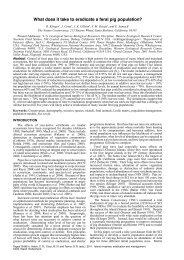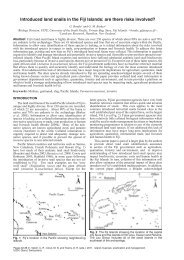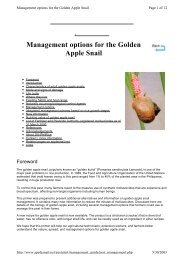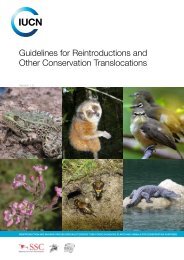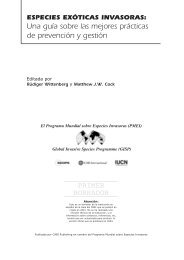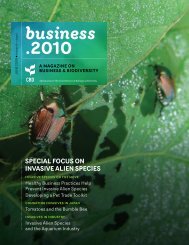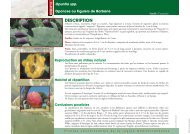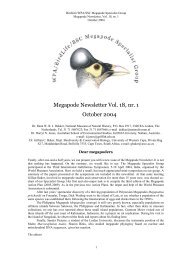Aliens Newsletter - ISSG
Aliens Newsletter - ISSG
Aliens Newsletter - ISSG
Create successful ePaper yourself
Turn your PDF publications into a flip-book with our unique Google optimized e-Paper software.
Editorial<br />
An article published in Science last 30 April 2010, by Butchart and colleagues, has compiled over 30 indicators<br />
measuring different aspects of biodiversity. It, has shown that there is no evidence of any reduction in the<br />
rate of decline of biodiversity and that, on the contrary, pressures continue to increase. These results confirm,<br />
with a solid science-based assessment of the available data, that the 2010 target has not been met, and that the<br />
efforts put in place by the world leaders to preserve the diversity of life have been largely inadequate.<br />
The Science article stated that biological invasions have increased in Europe by 76% in the last 40 years are<br />
increasing and invasive alien species - as stressed by the paper by McGeoch and co-authors published earlier<br />
this year in Diversity and Distribution (16, 95-108) – are indeed a major driver of biodiversity loss, that in many<br />
cases strongly affect the conservation status of threatened species.<br />
Both of these recent articles report on some encouraging developments: 83% of the world’s countries have signed<br />
international agreements to tackle invasive alien species, and 55% have adopted national legislation to control<br />
and/or limit the spread and impact of biological invasions.<br />
There are increasing cases of successful conservation actions, as in the case of the black stilt in New Zealand,<br />
whose extinction has been prevented through a combination of predator control, habitat restoration and translocation<br />
programs. As a result of active conservation, several threatened vertebrate species have improved their<br />
conservation status sufficiently to be down-listed to a lower category of threat on the IUCN Red List.<br />
It must be stressed that these positive outcomes are in most cases the consequence of successful eradication<br />
programs that have removed the predators affecting species of conservation concern. Eradication is in fact one<br />
of the most effective tools we have to respond to the continuing decrease in species’ numbers, also, the significant<br />
advances in eradication science that have been gathered in the past decades.<br />
The contributions presented at the international conference on “Island Invasives; eradication and management”,<br />
held in Auckland, New Zealand in early February (see the article in this issue), clearly demonstrate these advances.<br />
The number of eradications targeting several species simultaneously has much increased in recent years;<br />
the risk of undesired effects of eradications have been minimised, and adaptive implementation of eradications<br />
has prevented, or rapidly mitigated, potential unexpected chain reactions. Furthermore, we are now able to target<br />
not only vertebrates, but also plants and terrestrial invertebrates, and to remove invasive species from large<br />
areas, even on the mainland.<br />
But management of invasive species is not the only tool we have in our hands. The experiences gathered in<br />
several areas of the world have also shown that stringent biosecurity policies can prevent a large part of invasions,<br />
protecting not only the environment, but also economies. For example, if Australia remains free of the<br />
varroa mite – a pest that has caused the collapse of the honey industry in many countries of the world - this is<br />
likely due to the strict biosecurity policy adopted in that country. A large proportion of the economic losses to<br />
the European economy caused by invasive species could be prevented with stricter import regulations.<br />
As Stuart Butchart said, commenting on the article published in Science (of which he was the primary author),<br />
“2010 will not be the year that biodiversity loss was halted, but it needs to be the year in which we start taking<br />
the issue seriously and substantially increase our efforts to take care of what is left of our planet”. The efforts<br />
to tackle biological invasions will be a crucial test of a renewed global attention to the problems of the<br />
life on earth we all hope to see at the end of 2010.<br />
Piero Genovesi, <strong>ISSG</strong> Chair<br />
General disclaimer<br />
All material appearing in <strong>Aliens</strong> is the work of individual authors, whose names are listed at the foot of<br />
each article.<br />
Contributions are not refereed, as this is a newsletter and not an academic journal. Ideas and comments<br />
in <strong>Aliens</strong> are not intended in any way to represent the view of IUCN, SSC or the Invasive Species Specialist<br />
Group (<strong>ISSG</strong>) or sponsors, unless specifically stated to the contrary. The designation of geographical<br />
entities do not imply the expression of any opinion whatsoever on the part of IUCN, SSC, <strong>ISSG</strong><br />
or sponsors concerning the legal status of any country, territory, or area, or of its authorities, or concerning<br />
the delimitation of its frontiers or boundaries.<br />
<strong>Aliens</strong> 1



